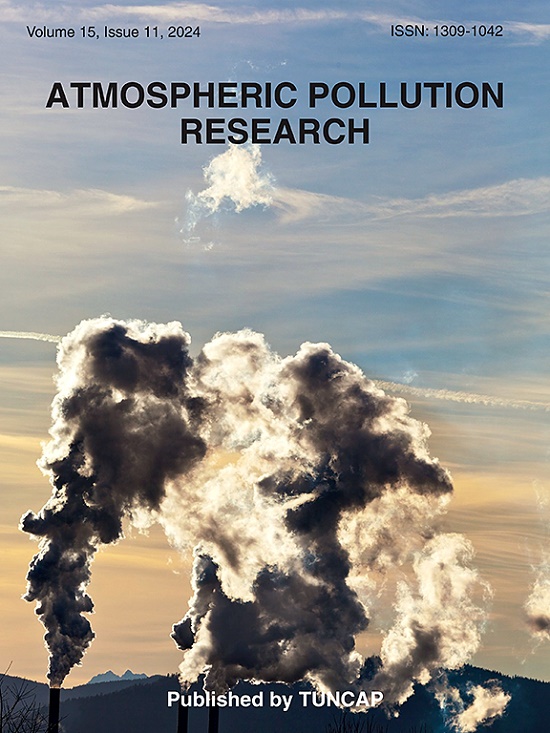The heat-pollution paradox: understanding the relationship between land surface temperature and air pollution in a heavily polluted megacity
IF 3.9
3区 环境科学与生态学
Q2 ENVIRONMENTAL SCIENCES
引用次数: 0
Abstract
In rapidly urbanizing megacities, increasing land surface temperature (LST) and acute air pollution present considerable environmental and public health issues. Urban sprawl, industrial discharges, and automotive emissions degrade air quality, while heat-absorbing surfaces exacerbate urban heat island (UHI) phenomena. Comprehending the correlation between LST and air pollution is essential, as elevated temperatures can exacerbate pollutant concentrations via photochemical reactions and meteorological alterations. This study aims to assess the relationship between LST and air pollution during winter and summer in Delhi (India) using Remote Sensing and National Air Quality Monitoring Program (NAMP). The findings showed that the LST in Delhi exhibited seasonal variation, with summer LST reaching a maximum of 31.08 °C (mean: 28.99 °C) and winter LST declining to 16.30 °C (mean: 18.29 °C). Elevated LST were recorded in the northern, eastern, and western regions during the summer season. Air pollution exacerbated in winter, with particulate matter i.e. PM2.5 and PM10 concentrations attaining 277.13 μg/m3 and 228.33 μg/m3, respectively, whilst O3 concentrations peak in summer at 41.08 μg/m3. The core areas maintained higher LST than the transitional zones. PM10 exhibited a strong correlation with LST (winter: 0.611, summer: 0.222), affecting heat retention, but CO and O3 demonstrated weak correlations relationships. Increased winter PM10 levels (0.767) correlated with heightened summer surface UHI (SUHI), underscoring the significance of PM in warming. The study emphasized the necessity of targeted mitigation strategies, such as the expansion of urban natural infrastructure, to mitigate LST and air pollution. Policies should prioritize the integration of heat mitigation measures into city planning, the enhancement of air quality monitoring, and the regulation of winter PM levels.

热污染悖论:了解重污染大城市地表温度与空气污染之间的关系
在快速城市化的特大城市中,不断上升的地表温度(LST)和严重的空气污染带来了巨大的环境和公共卫生问题。城市无序扩张、工业排放和汽车尾气使空气质量下降,而吸热表面则加剧了城市热岛(UHI)现象。了解 LST 与空气污染之间的相关性至关重要,因为温度升高会通过光化学反应和气象变化加剧污染物浓度。本研究旨在利用遥感技术和国家空气质量监测计划(NAMP)评估印度德里冬季和夏季的 LST 与空气污染之间的关系。研究结果表明,德里的 LST 呈现季节性变化,夏季 LST 最高达 31.08 °C(平均值:28.99 °C),冬季 LST 则降至 16.30 °C(平均值:18.29 °C)。在夏季,北部、东部和西部地区的 LST 都有所升高。冬季空气污染加剧,颗粒物,即 PM2.5 和 PM10 浓度分别达到 277.13 微克/立方米和 228.33 微克/立方米,而臭氧浓度在夏季达到峰值,为 41.08 微克/立方米。核心区的 LST 始终高于过渡区。PM10 与 LST 有很强的相关性(冬季:0.611,夏季:0.222),影响了热量的保持,但 CO 和 O3 的相关性较弱。冬季 PM10 水平的增加(0.767)与夏季地表 UHI(SUHI)的增加相关,突出了 PM 在气候变暖中的重要作用。该研究强调,必须采取有针对性的减缓战略,如扩大城市自然基础设施,以减缓 LST 和空气污染。相关政策应优先考虑将热量减缓措施纳入城市规划、加强空气质量监测以及调节冬季可吸入颗粒物水平。
本文章由计算机程序翻译,如有差异,请以英文原文为准。
求助全文
约1分钟内获得全文
求助全文
来源期刊

Atmospheric Pollution Research
ENVIRONMENTAL SCIENCES-
CiteScore
8.30
自引率
6.70%
发文量
256
审稿时长
36 days
期刊介绍:
Atmospheric Pollution Research (APR) is an international journal designed for the publication of articles on air pollution. Papers should present novel experimental results, theory and modeling of air pollution on local, regional, or global scales. Areas covered are research on inorganic, organic, and persistent organic air pollutants, air quality monitoring, air quality management, atmospheric dispersion and transport, air-surface (soil, water, and vegetation) exchange of pollutants, dry and wet deposition, indoor air quality, exposure assessment, health effects, satellite measurements, natural emissions, atmospheric chemistry, greenhouse gases, and effects on climate change.
 求助内容:
求助内容: 应助结果提醒方式:
应助结果提醒方式:


